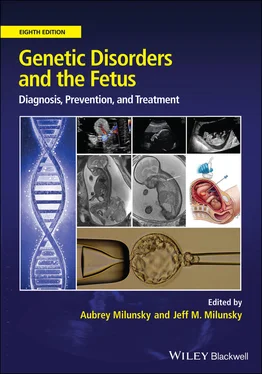Genetic Disorders and the Fetus
Здесь есть возможность читать онлайн «Genetic Disorders and the Fetus» — ознакомительный отрывок электронной книги совершенно бесплатно, а после прочтения отрывка купить полную версию. В некоторых случаях можно слушать аудио, скачать через торрент в формате fb2 и присутствует краткое содержание. Жанр: unrecognised, на английском языке. Описание произведения, (предисловие) а так же отзывы посетителей доступны на портале библиотеки ЛибКат.
- Название:Genetic Disorders and the Fetus
- Автор:
- Жанр:
- Год:неизвестен
- ISBN:нет данных
- Рейтинг книги:4 / 5. Голосов: 1
-
Избранное:Добавить в избранное
- Отзывы:
-
Ваша оценка:
- 80
- 1
- 2
- 3
- 4
- 5
Genetic Disorders and the Fetus: краткое содержание, описание и аннотация
Предлагаем к чтению аннотацию, описание, краткое содержание или предисловие (зависит от того, что написал сам автор книги «Genetic Disorders and the Fetus»). Если вы не нашли необходимую информацию о книге — напишите в комментариях, мы постараемся отыскать её.
Genetic Disorders and the Fetus — читать онлайн ознакомительный отрывок
Ниже представлен текст книги, разбитый по страницам. Система сохранения места последней прочитанной страницы, позволяет с удобством читать онлайн бесплатно книгу «Genetic Disorders and the Fetus», без необходимости каждый раз заново искать на чём Вы остановились. Поставьте закладку, и сможете в любой момент перейти на страницу, на которой закончили чтение.
Интервал:
Закладка:
Incidence/prevalence rates of congenital defects are directly influenced by when and how diagnoses are made. Highlighting the importance of how early a diagnosis is made after birth, the use of echocardiography, and the stratification of severity of congenital heart defects, Hoffman and Kaplan 48clarified how different studies reported the incidence of congenital heart defects, varying from 4 in 1,000 to 50 in 1,000 livebirths. They reported an incidence of moderate and severe forms of congenital heart disease in about 6 in 1,000 livebirths, a figure that would rise to at least 19 in 1,000 livebirths if the potentially serious bicuspid aortic valve is included. They noted that if all forms of congenital heart disease (including tiny muscular ventricular septal defects) are considered, the incidence increases to 75 in 1,000 livebirths.
The newer genetic technologies, including chromosomal microarray, whole‐exome sequencing, next‐generation sequencing, and whole‐genome sequencing, have helped unravel the causes of an increasing number of isolated or syndromic congenital heart defects. 49 , 50Identified genetic causes include monogenic disorders in 3–5 percent of cases, chromosomal abnormalities in 8–10 percent, and copy number variants in 3–25 percent of syndromic and 3–10 percent of isolated congenital heart defects. 49 , 51A next‐generation sequencing study indicated that 8 percent and 2 percent of cases were due to de novo autosomal dominant and autosomal recessive pathogenic variants, respectively. 52
Pregestational diabetes in 775 of 31,007 women was statistically significantly associated with sacral agenesis (OR 80.2), holoprosencephaly (OR 13.1), limb reduction defects (OR 10.1), heterotaxy (12.3), and severe congenital heart defects (OR 10.5–14.9). 53
Maternal obesity is associated with an increased risk of congenital malformations. 54 – 65The greater the maternal body mass index (BMI), the higher the risk, especially for congenital heart defects, 59 , 60 , 62 , 65with significant odds ratios between 2.06 and 3.5. In a population‐based case–control study, excluding women with preexisting diabetes, Block et al. 66compared the risks of selected congenital defects among obese women with those of average‐weight women. They noted significant odds ratios for spina bifida (3.5), omphalocele (3.3), heart defects (2.0), and multiple anomalies (2.0). A Swedish study focused on 1,243,957 liveborn singletons and noted 3.5 percent with at least one major congenital abnormality. 64These authors used maternal BMI to estimate risks by weight. The risk of having a child with a congenital malformation rose steadily with increasing BMI from 3.5 percent (overweight) to 4.7 percent (BMI ≥40). Our own 67 , 68and other studies 69have implicated the prediabetic state or gestational diabetes as contributing to or causing the congenital anomalies in the offspring of obese women. In this context, preconception bariatric surgery seems not to reduce the risks of congenital anomalies. 61 , 70 – 72It appears that folic acid supplementation attenuates but does not eliminate the risk of spina bifida when associated with diabetes mellitus 73or obesity 74(see Chapter 10). In contrast, markedly underweight women reportedly have a 3.2‐fold increased risk of having offspring with gastroschisis, 74in all likelihood due to smoking and other acquired exposures. 75 , 76Indeed, a study of 173,687 malformed infants and 11.7 million unaffected controls, when focused on maternal smoking, yielded significant odds ratios up to 1.5 for a wide range of major congenital malformations in the offspring of smoking mothers. 77Young nulliparous women have an increased risk of bearing a child with gastroschisis, those between 12 and 15 years of age having a more than fourfold increased risk. 78A Californian population‐based study (1995–2012) recorded a prevalence for gastroschisis of 2.7 cases per 10,000 livebirths. 75
The surveillance system of the National Network of Congenital Anomalies of Argentina reported a 2009–2016 study of 1,663,610 births with 702 born with limb reduction defects. 79The prevalence was 4.22/10,000 births. In 15,094 stillbirths, the prevalence rose to 30.80/10,000. A Chinese study of 223 newborn deaths in a neonatal intensive care unit noted that 44 (19.7 percent) had a confirmed genetic disorder. 80The National Perinatal Epidemiology Centre in Ireland in a study of fatal fetal anomalies recorded 2,638 perinatal deaths, 939 (36 percent) having a congenital anomaly, 43 percent of which were chromosomal. 81More than a single anomaly was noted in 36 percent (333 of 938) of their cases. These numbers led to a significant genetic disease burden and have accounted for 28–40 percent of hospital admissions in North America, Canada, and England. 82 – 84Notwithstanding their frequency, the causes of about 60 percent of congenital malformations remain obscure. 85 , 86
The effect of folic acid supplementation, via tablet or food fortification, on the prevalence of neural tube defects (NTDs), is now well known to reduce the frequency of NTDs by up to 70 percent 87 , 88(see Chapter 10). A Canadian study focused on the effect of supplementation on the prevalence of open NTDs among 336,963 women. The authors reported that the prevalence of open NTDs declined from 1.13 in 1,000 pregnancies before fortification to 0.58 in 1,000 pregnancies thereafter. 89
In a population‐based cohort study by the Metropolitan Atlanta Congenital Defects Program, the risk of congenital malformations was assessed among 264,392 infants with known gestational ages, born between 1989 and 1995. Premature infants (<37 weeks of gestation) were found to be more than twice as likely to have been born with congenital malformations than infants at term. 90In a prospective study of infants weighing 401–1,500 g between 1998 and 2007, a congenital malformation was noted in 4.8 percent of these very low birthweight infants. The mean gestational age overall was 28 weeks and the mean birthweight was 1,007 g. 91A surveillance study of births, stillbirths, and fetuses for malformations in a single center with 289,365 births over 41 years noted 7,020 (2.4 percent) with one or more congenital abnormalities. 92Twins have long been known to have an increased rate of congenital anomalies. A UK study of 2,329 twin pregnancies (4,658 twins) and 147,655 singletons revealed an anomaly rate of 405.8 per 10,000 twins versus 238.2 per 10,000 singletons (relative risk [RR] 1.7). 93The prevalence rate of anomalies among known monochorionic twins (633.6 per 10,000) was nearly twice that found in dichorionic twins (343.7 per 10,000) (RR 1.8). A California Twin Registry study of 20,803 twin pairs found an overall prevalence of selected anomalies of 38 per 1,000 persons. 94
The frequency of congenital defects is also influenced by the presence or absence of such defects in at least one parent. A Norwegian Medical Birth Registry population‐based cohort study of 486,207 males recorded that 12,292 (2.53 percent) had been born with a congenital defect. 95Among the offspring of these affected males, 5.1 percent had a congenital defect, compared with 2.1 percent of offspring of males without such defects (RR 2.4). Ethnicity, too, has a bearing on the prevalence of cardiovascular malformations. In a New York State study of 235,230 infants, some 2,303 were born with a cardiovascular malformation. The prevalence among non‐Hispanic white (1.44 percent) was higher than in non‐Hispanic black individuals (1.28 percent). 96However, racial/ethnic disparities clearly exist for different types of congenital defects. 97
Congenital hypothyroidism is associated with at least a fourfold increased risk of congenital malformations, and represents yet another factor that may influence incidence/prevalence rates of congenital anomalies and neurodevelopment. 98 , 99A French study of 129 infants with congenital hypothyroidism noted that 15.5 percent had associated congenital anomalies. 100Nine of the infants had congenital heart defects (6.9 percent).
Читать дальшеИнтервал:
Закладка:
Похожие книги на «Genetic Disorders and the Fetus»
Представляем Вашему вниманию похожие книги на «Genetic Disorders and the Fetus» списком для выбора. Мы отобрали схожую по названию и смыслу литературу в надежде предоставить читателям больше вариантов отыскать новые, интересные, ещё непрочитанные произведения.
Обсуждение, отзывы о книге «Genetic Disorders and the Fetus» и просто собственные мнения читателей. Оставьте ваши комментарии, напишите, что Вы думаете о произведении, его смысле или главных героях. Укажите что конкретно понравилось, а что нет, и почему Вы так считаете.












